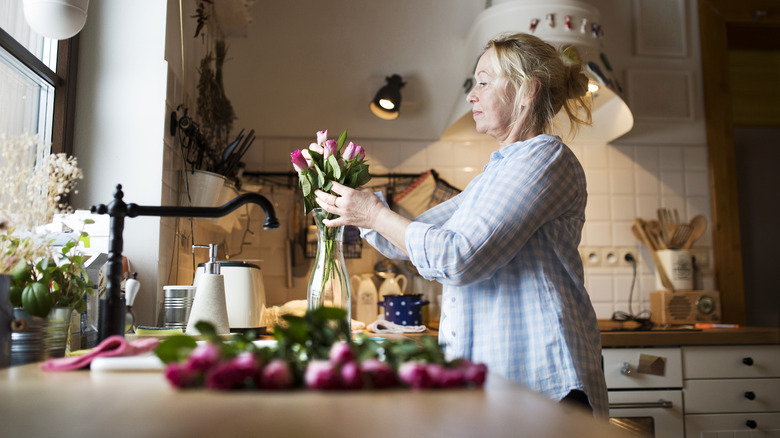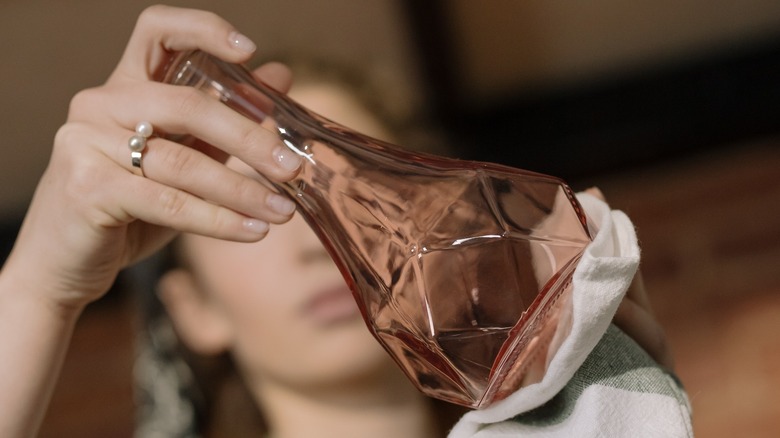One Unexpected Kitchen Staple Will Totally De-Grime Your Cloudy Flower Vase
Is your vase a little grimy after your latest bouquet? No worries! As it turns out, cleaning out leftover grime is as easy as pie — so it's only fitting that the ingredients required are probably already in your kitchen.
Few things make a room's decor feel intentional like a beautiful bouquet of flowers. However, as anyone who has kept a bunch going for a while will know, by the end of those blooms' lifespan, there tends to be a leftover layer that leaves glass vases cloudy. The cloudiness is caused by contaminated water. Said contamination occurs when stems begin to decompose — however, decomposition is also often helped along by the vase itself. A dirty vase means water gets contaminated faster. Et voila, the vicious cycle continues.
Granted, sometimes, cloudy glass post-posy can also be caused by the type of water used. The high levels of calcium in hard water create a cloudy haze on glass. The good news is that no matter what's causing that dreaded discoloration, it's still possible to get those vases back to their shining glory. The best part is, you're likely to have the miracle cure on hand.
Vinegar with a little salt works wonders for cloudiness
We weren't kidding when we said you probably had the miracle cure for cloudy glass in your kitchen. Enter, white vinegar and salt: the dynamic duo that's as effective on discolored glass as it is delicious on chips.
For cloudy glass that just isn't dissipating no matter how hard you scrub, combine vinegar and salt into a paste (starting off with just one tablespoon of salt). From there, work the mixture into the vase, focusing on the discolored sections. After about 10 minutes, the vase is ready for a rinse and should come out cloud-free. Simple, yet effective.
That salt and vinegar are something of a dream team when it comes to cleaning stained vases isn't exactly surprising. Salt is both abrasive and absorbent - a great combination for getting out stains. Vinegar, meanwhile, has also long been touted as a versatile cleaning supply. Vinegar is acidic enough to break down tough stains while being gentle enough for use on more delicate materials. With that in mind, it's not exactly surprising that vinegar regularly pops up in other DIY vase-cleaning hacks.
Vinegar also works effectively on its own
While a salt and vinegar paste makes sense for more heavy-duty discoloration, it's not always necessary to do quite so deep a clean. When it comes to milder stains, white vinegar on its own is also said to work some serious magic.
Leaving a vase in vinegar overnight is generally pretty effective at getting rid of cloudiness. Simply pour vinegar up to the affected area, then rinse the following morning. Hey presto, cleaner glassware. However, if you're on a stricter timeline and need to put that fresh bunch out as soon as possible, there's a way to speed up the process. Martha Stewart recommends warming the vinegar up beforehand, then leaving the vase in the warmed-up vinegar for just one hour. Once again, give the vase a rinse, and it should be good to go.
Having a floral arrangement can do wonders for your home, whether you're hosting or just want something to beautify your space. Just be sure to clean out those vases between uses to avoid a foggy situation. Thanks to just one nifty ingredient, it's easy enough to do. Plus, as a bonus, your flowers will thank you for it.

